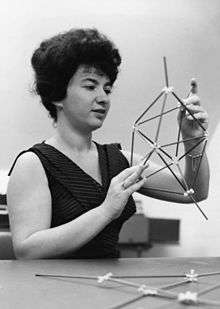Joyce Jacobson Kaufman

Joyce Jacobson Kaufman (born 21 June 1929) is a Jewish American chemist. In 1972 she introduced the concept of conformational topology and applied it to biomedical molecules. Kaufman also published a landmark paper in 1980 in which she described a new theoretical method for coding and retrieving certain carcinogenic hydrocarbons. She was invited by NSF to use the Cray X-MP (1985) and YMP (1989) supercomputers at the San Diego Supercomputer Center.[1]
Early life
Kaufman was born in the Bronx to Robert and Sarah (Seldin) Jacobson. After her parents separated in 1935, she was raised in Baltimore, Maryland, by her mother and immigrant maternal grandparents. In 1940, her mother married Abraham Deutch, a successful roofer. Deutch was born in Riga (the capital of Latvia), and immigrated to the United States in 1924 after having spent seven years as a halutz [pioneer] in Palestine. He helped raise Joyce as her stepfather.[2]
Personal Life She married Stanley Kaufman on December 26, 1948 and they divorced in 1982. They had one child, Jan Caryl, born June 24, 1955 who became a rabbi in 1979.
Chemistry career
Kaufman knew she wanted to be a chemist at age eight after reading a biography of Marie Curie. That year she was chosen to attend a summer course at Johns Hopkins University for gifted children in math and science. In 1945, she was admitted as a special student to Johns Hopkins University, which did not grant women regular student status until 1970. Kaufman earned her B.S. with honors in Chemistry from Johns Hopkins University in 1949.[2][3][4]
She then worked as a technical librarian and later a research chemist at the Army Chemical Center. In 1952 she returned to Johns Hopkins as a researcher in the physical chemistry lab of her former professor, Walter S. Koski, who later became her second husband. Kaufman received her M.A. in 1959 and her Ph.D. in physical chemistry in 1960. Koski was her adviser and mentor. In 1962, accompanied by her mother and her young daughter, she went to Paris, where she became a visiting scientist, receiving a doctoral degree in theoretical physics from the Sorbonne the following year.[3]
Later Kaufman came back to Johns Hopkins as a principal research scientist, a position which she held until her retirement. She also held a joint appointment in the Johns Hopkins School of Medicine as associate professor of anesthesiology and later of plastic surgery, but she never received tenure or promotion to full professor, possibly due to discrimination against her as a woman.[3]
Kaufman is noted for carrying out the first all-valence-electron, three-dimensional quantum-chemical calculations, and for research on the clinical effects of tranquilizers and narcotic drugs.[5]
Honors
In 1960, she earned her doctorate and a long-overdue Phi Beta Kappa key (as a special student, she could not receive this award when she graduated with her bachelor's degree).[6] In 1965 Kaufman was elected as a fellow of the American Institute of Chemists.[5] In 1966 she was elected as a fellow of the American Physical Society.[5] In 1969 she was named Dame Chevalière de France. In 1973 she received the Garvan Medical Award of the American Chemical Society. In 1974 the Jewish National Fund honored her with a Woman of Achievement Award as one of ten outstanding women in Maryland.[3] In 1981 she was elected corresponding member of the European Academy of Sciences and Arts.
References
- ↑ "JCE Online: Biographical Snapshots: Snapshot". Jchemed.chem.wisc.edu. Retrieved 2011-08-18.
- 1 2 "Joyce Jacobson Kaufman | Jewish Women's Archive". Jwa.org. Retrieved 2011-08-18.
- 1 2 3 4 "Kaufman, Joyce Jacobson". Jewishvirtuallibrary.org. Retrieved 2011-08-18.
- ↑ "JCE Online: Biographical Snapshots: Snapshot". Jchemed.chem.wisc.edu. Retrieved 2011-08-18.
- 1 2 3 "Joyce Jacobson Kaufman Record". Smithsonian Institution Archives Collections Website. Smithsonian Institution Archives. Retrieved 5 June 2013.
- ↑ https://jwa.org/encyclopedia/article/kaufman-joyce-jacobson